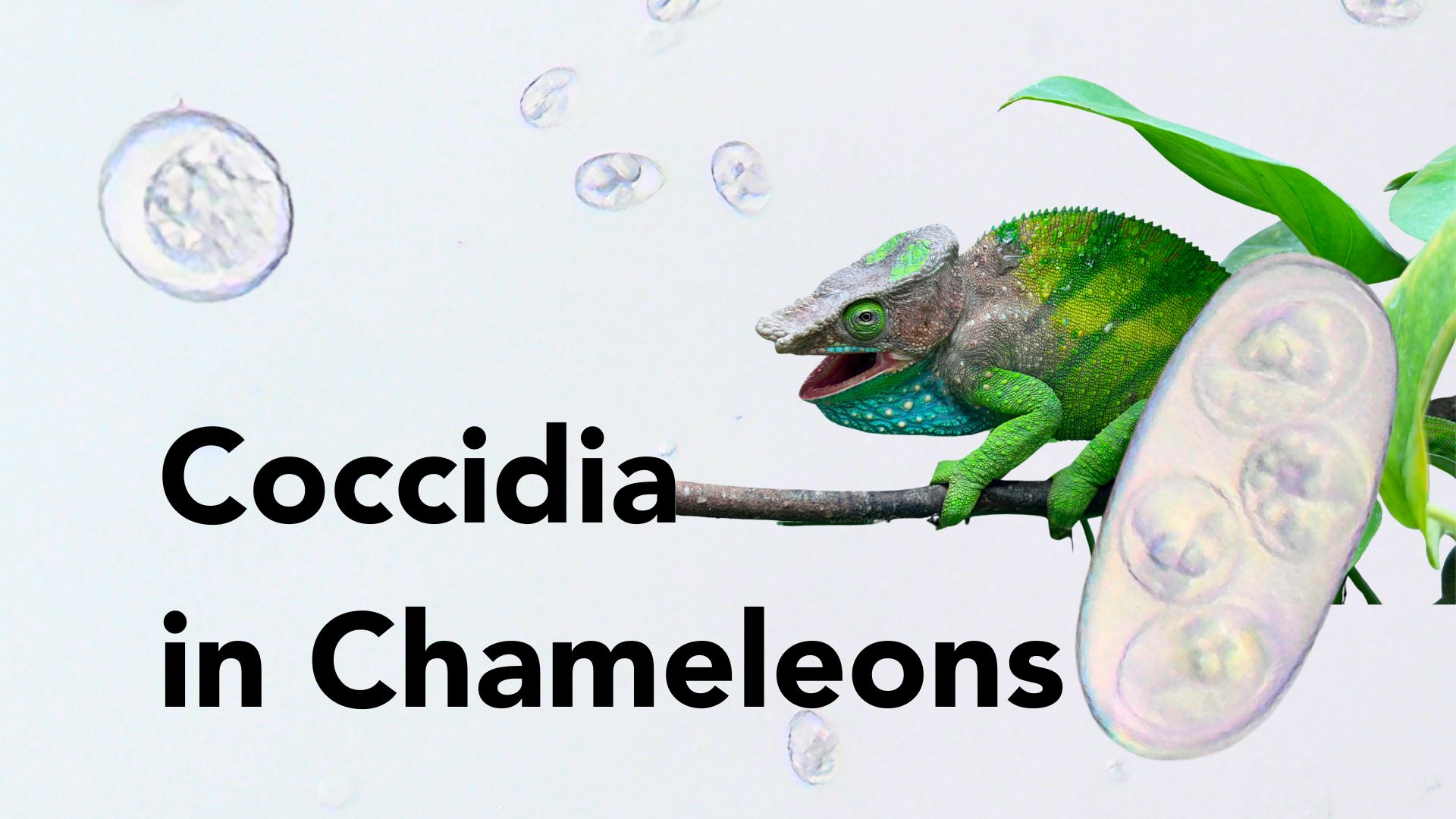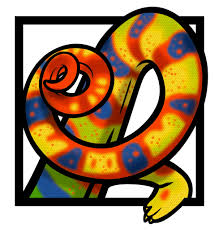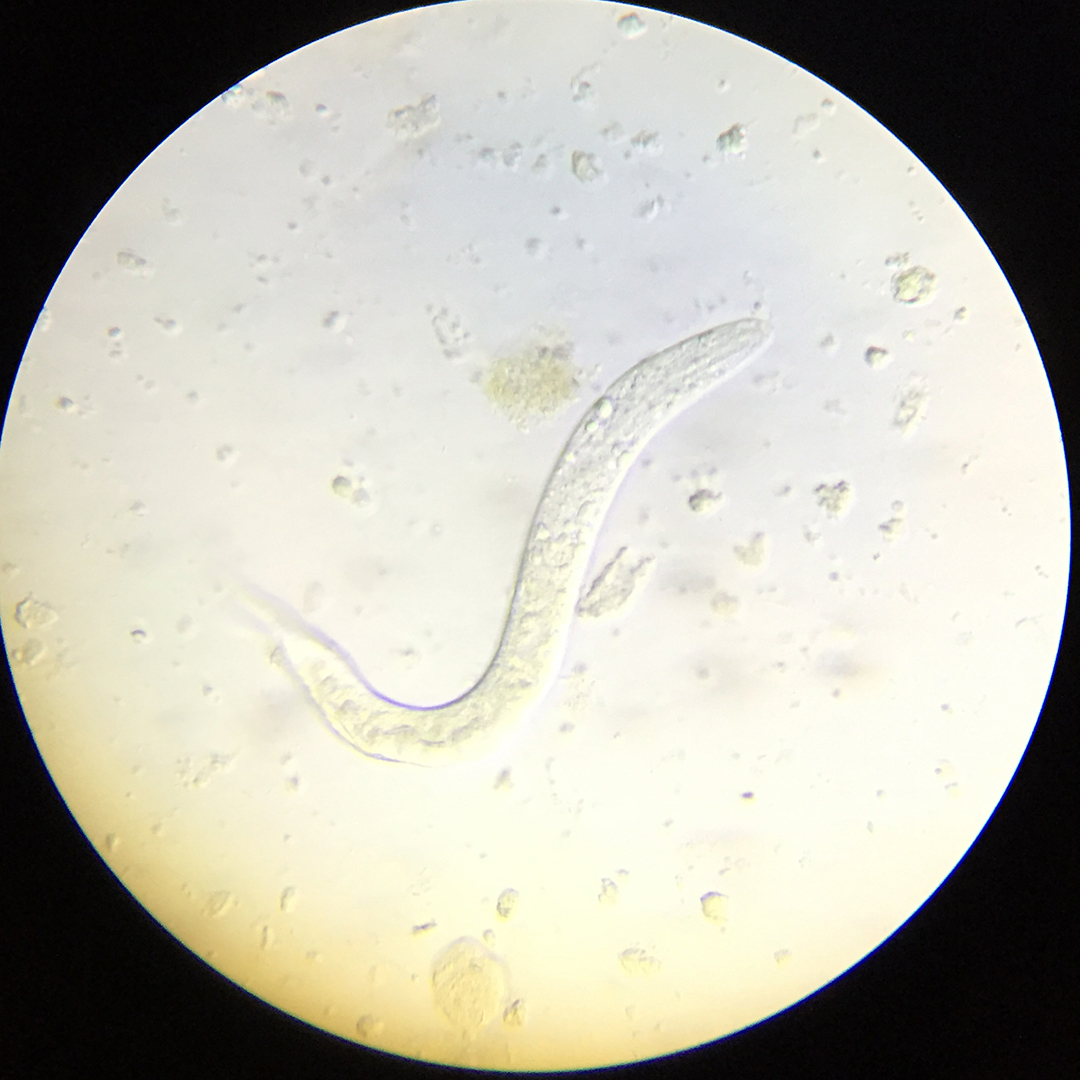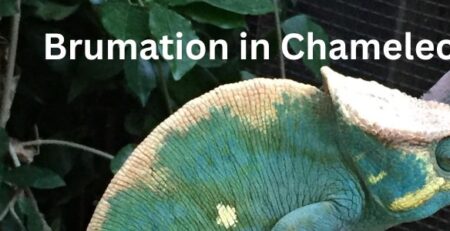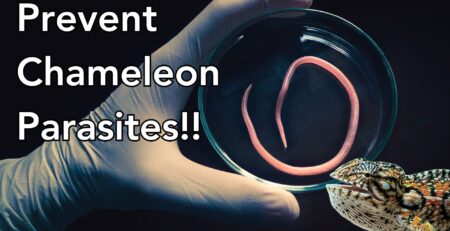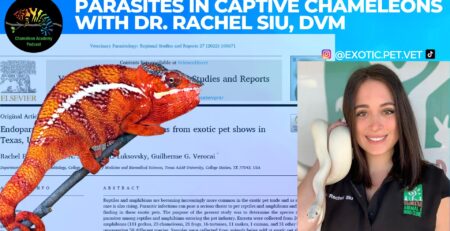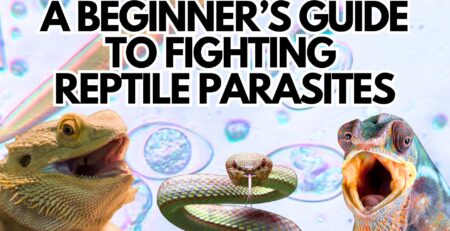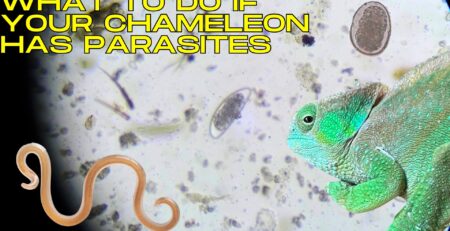Coccidia Parasites in Chameleons
Coccidia is a parasite of chameleons. The number of coccidia oocysts can grow to ridiculous numbers in the confines of your chameleon’s cage so we need to act decisively to protect our chameleons!

Listen to the Coccidia Parasites and Chameleons Podcast Episode
This episode will give you a thorough review of the coccidia lifecycle and relationship with your chameleon!
Introduction to Coccidia
Coccidia is a single cell protozoan parasite which causes issues by stealing nutrients from the host and damaging the intestinal wall. It can multiply to extreme numbers and, left unchecked, can cause death.
A coccidia infection is identified by the presence of oocysts in the feces. Oocysts are a special kind of cyst. A cyst is when an organism wraps itself into a thick shelled ball and goes dormant until conditions are right for it to continue its lifecycle. Cysts are environmentally resistant and hard to kill. The difference with coccidia oocysts is that an oocyst is not dormant. It is actively preparing to become infectious. Inside the host, Coccidia mostly inhabits the intestines. Certain species can also be found in the liver and gall bladder. Coccidia oocysts are very difficult to kill. They have a high resistance to many of our disinfectants. One of the few weaknesses is a vulnerability to temperatures over 60C which leads to steam cleaning being used in some cases.
In the wild, coccidia can be carried without it being life threatening. The chameleon’s immune system actively keeps the infection down and the chances of getting subsequent oocysts are slim due to the challenges of getting an oocyst from the forest floor into the mouth of a chameleon. Coccidia becomes a major health threat in captivity because we are trapping the chameleon and its food into the same small space as a coccidia infection producing oocysts at the same rate as it is trying to coat the Madagascar forests. So, captivity is a huge imbalance to the chameleon/coccidia relationship. We must bring balance back through disciplined hygiene practices. Since the immune system is the major player in eradicating the coccidia in the body, any weakening of the immune system due to husbandry stress benefits the coccidia. Husbandry and Hygiene are first priorities when dealing with an infection and to prevent it from happening in the first place.
The Coccidia Oocyst
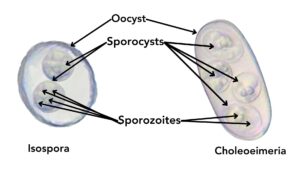
This is an example of the typical Isospora and Choleoeimeria oocysts. Inside the environmentally resistant outer shells you see sporocysts. Inside these sporocysts, infectious sporozoite cells are being developed. When infectious, the Isospora coccidia will have two sporocysts that you can see and the Choleoeimeria oocyst will show four sporocysts. They both will have eight sporozoites being developed in those sporocysts.
In nature, a coccidia infection is general kept in check by a health immune system and the astronomical odds against a microscopic, non-mobile oocyst dropped to the forest floor far below ever making it back to a chameleon’s mouth. Coccidia tries to make up for this handicap by being a voracious producer of oocysts to raise the odds that a few can make it back to a chameleon. Obviously they have figured out how to make it work!
But we destroy this balance when we put the definitive host, our chameleon, in a relatively small space (a cage) with feeder insects (the perfect vehicle to hitch a ride with), and internal coccidia that don’t know that they don’t have to produce enough oocysts to blanket the Madagascar forest floor. So you have millions of oocysts inside a cage with feeder insects and your chameleon. Just a couple of crickets that ran through the puddle at the bottom of your cage and nibbled on something in the poop could deliver to your chameleon what could be a lifetime’s worth of oocysts in one mouth full! So it is imperative that we bring balance to the captive environment by top notch husbandry and obsessive chameleon cage bottom hygiene!
How to find Coccidia in Chameleons
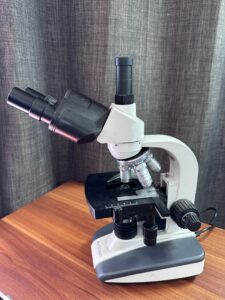
Coccidia will be able to be found on both the direct fecal smear and the fecal float. A trained eye will be able to pick them out from the debris at 200X magnification, though it is easier when you start out to look for them at 400x magnification. 400x is a good balance between easily spotting them without getting so close that you can’t see beyond 100 micrometers either side. Remember that magnification is the product of the eyepiece magnification and the objective magnification. There are a disturbing number of images floating around that list only the objective value! I put on some good music and do a high level scan at 100x to look for nematodes and their ova. I then go down to 400x to look for the frenetic movement of the flagellated protozoa and the tell-tale shapes of entamoeba and the star of this post, coccidia.
There is enormous advantage to learning to do your own chameleon fecal analysis. This allows you to catch infections when they are just starting and you are able to medicate the chameleon before the parasitic infection blows out of control and then becomes a challenge to control. Once the chameleon is showing clinical signs we are in the danger zone!
How to Medicate your chameleon for Coccidia
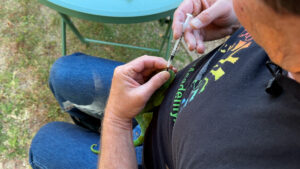
The medicine traditionally used to treat coccidia has been Sulfadimethoxine, commonly called Albon. This is a sulfa drugs that has a history of success. It is a coccidiostat, which means that it stops the coccidia from growing and continuing its lifecycle. It doesn’t kill the coccidia and so you need to give the medicine for a length of time to allow the chameleon’s immune system to clean up the various coccidia forms and exceed the coccidia’s lifespan. Sulfa drugs are hard on the kidneys so we used them with great care.
My preferred medicine is Ponazuril. Ponazuril is a coccidiocide, which means it kills the coccidia in many of its different forms in the body. Coccidia likes to invade cells and use them as cover while they develop. Ponazuril kills them in the cells. Ponazuril only takes two doses and is easier on the chameleon’s body. I have had success with Ponazuril and so that is now my preferred medication for coccidia in my chameleons. Toltrazuril is related to Ponazuril and has the same effect. (In fact, Ponazuril is a metabolite of Toltrazuril)
Learn how to do your own Chameleon Fecals
Hunting Microscopic Chameleon Parasites is an in depth course which will get you familiar with the world of parasites and your chameleon. By the end of this course you will know what to look for in a microscope, how to set up the slides for a direct fecal smear and fecal float test, be familiar with the varieties of parasites and the medicines used to treat them, and be comfortable discussing all of this with your veterinarian. This is a community powered course and you will have the instructor, Bill Strand, your fellow students, and course alumni there to consult and help you along. This is an asynchronous course so you can take it whenever you want at whatever pace you want, but you will not be doing it alone. We all are there if you have a question!
Tap here for more information

